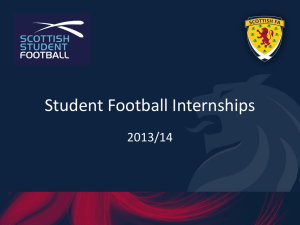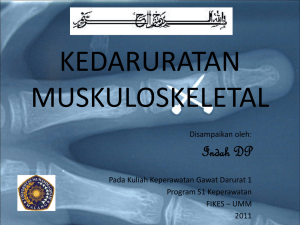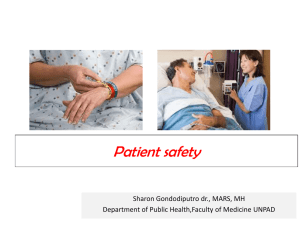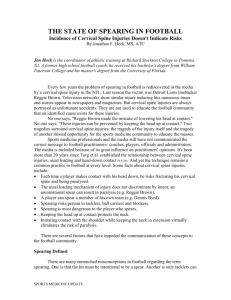Tropic Training PPT - Jakarta Schools Football League
advertisement
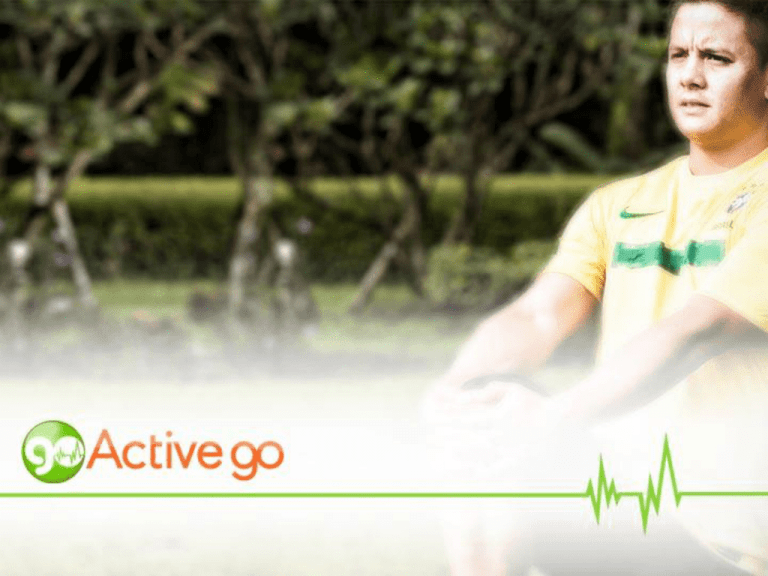
To discuss 1. Training state in Indonesia (place, climate, culture) 2. Periodization plan 3. Training plan for U8; U10; U12 4. Football injuries 5. First Aid – how? and the basic you need Indonesia Geography background Different places e.g. Home & away game - Climates - Transportation - Food - Football? Periodization Definition Individual and Team Kids Periodization Conditioning training? Advantage: - Fit and energized - Getting mobile in the pitch Disadvantage: - Growth related - Has the capability to lose skill - Injury (joint, muscle) Periodization The relation to periodization in tropic weather: - Thirst - Performance - Burn/heat stroke - Condition The need of adaptation Training Training plan U-8 • Basic fundamental training It is designed to introduce the basic of football so the children will have a total enjoyment in the game • The activities - Having fun - kicking ball - control ball - a basic idea of organization - frequency 2x a week with a game in the weekend • Training plan U-10 Training the basic. The children here are designed to start the early stage of training and start to have the basic concept of playing • The activities - what is training - what is discipline - what is focus - Player position function and definition Training plan U-12 on this level the children are designed to start learning the basic component of training Activities: - learn how defend - learn how to attack - learn a few different types of component which related to physical condition Injury Injury -- Cedera Natural Recovery Time Types Rehabilitation + 90-100 % normal strength Muscle > 1 week 6 weeks – 6 months Tendon > 10 days 30 – 40 weeks Ligament > 6 weeks 40 – 50 weeks Bone 3-4 months 12 months Cartilage > 2 months 6 months Cedera Musculoskeletal • Cedera ligamen sprain • Cedera otot (strain) • Cedera tulang (fraktur) Basic principal of handling injury • • • • • • The injury surface – big, small, hidden Inflamation and painful Purpose to have a good start ROM – Flexibility, mobility, and strength, Active Exercise TACKLE the problem – avoiding chronic disease The clinical problem Sports related injury (football) in the early age has become important The increase of football schools = more young players = more injured players Football is the largest sport in Indonesia Many players from young age got injured and it creates problem for themselves and also their community A serious football injuries especially knee can contribute to having a risk of developing osteoarthritis The Injuries needed treatment but here the means are lacking Football injury - Lower extremity has the most frequent case - Knee and ankle has the highest rate of injuries Extrinsic Risk Factors Intrinsic Risk Factors Non-modifiable Modifiable - - Previous injury - Age - Gender Sport played Level of play (recreational/prof) Position played Weather Time of season/time of day Non-modifiable Modifiable - - Rules Playing time Surface equipment Fitness levels Flexibility & Strength Joint stability Balance/propriocepsis Psychological factor What should be done…? - Focus on stability, coordination and flexibility training - Basic strengthening technic - The training is developed base on the risk factors and the most injury cases Risk Factors for the young one - the musculoskeletal system (tendons & ligaments stronger than bones) - bone getting stronger/harder but sudden impact can cause permanent damage (bow or buckle) - Decreased flexibility and stability because bone lengthening - Poor physical fitness - Increased BMI (weight(kg)/height (m)2) - 45kg / 1.42x1.42 = 22.317 Potential damage 1. Osgood schlatter 2. ACL Ligament – injury High level of exposure at a time of major physiological change 3. Dislocation of shoulder, elbow, patella 4. Soft tissue injuries – muscles, tendon Quadriceps and Achilles tendon 5. Overtraining and overuse Heat exhaustion - Children produce more and quick heat compare to body mass - low sweating capacity and drink less - in hot climates get exhausted very quick (has a huge potential to increase the risk of injuries) DEHYDRATION The importance of liquid 60-80% of our body consists of liquid 2% dehidrasi decrease in performance Dehydration symptoms Dry mouth Weak Tears Headache Fainted Belly ache Cramp What happen if you are dehydrated? Dry skin Fainted Disorientated Low blood pressure Temperature raise Organ malfunction Death First aid equipment Thank You!




